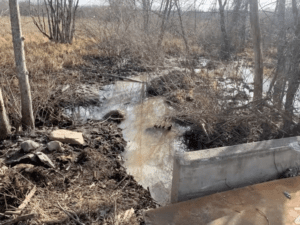
NORTHBOROUGH – Beaver dams and contractors’ efforts to dislodge those dams left as much as three feet of standing water pooled across seven acres near the old Westborough State Hospital late last year, according to Northborough Conservation Agent Mia McDonald.
That deposited sediment in protected wetland resource areas and, in turn, prompted McDonald to issue a violation against the state Division of Capital Asset Management and Maintenance (DCAMM).
Her violation, in part, called for all work within 100 feet of the wetland resource area to immediately stop until the area was stabilized to prevent further altering the wetland resource area.
Contractors wrestle with beaver problem
Plans for the old Westborough State Hospital site call for the demolition of 11 buildings.
The area in question straddles Northborough and Westborough. DCAMM, which oversees the site, had hired contractors to complete that demolition work, including demolition of several tanks.
Contractors were also required to both install erosion controls and inspect, maintain and restore the functionality of a culvert under a service road on the property.
That became difficult, however, as beavers dammed up openings in the culvert on a nightly basis.
With their culvert routinely blocked, crews lost what would have been an overnight drainage period.
“There’s so many beavers,” McDonald said during a Dec. 13 Conservation Commission meeting. “It’s like a beaver subdivision.”
Contractors jammed dead tree into culvert, town official says
Prior to the week of Thanksgiving, crews were trying to release a particular pond of water.
“It was [a] slow release,” McDonald said. “They put in a lot of controls and some sheeting to protect the overflow.”
She said crews used a sandbag wall and slowly removed the beavers’ materials. The water level was eventually lowered to expose the service road.
The initial water release went well, McDonald said.
After Thanksgiving, however, when McDonald visited the site again, she observed a large amount of standing water across part of the property.
A sudden release of water had spread sediment across the area.
As of the December meeting, DCAMM’s James Matz said they were still vetting how the sediment release occurred, though their understanding was that the beaver dam was removed on the downstream and upstream ends of the culvert.
The force of the water led to the sediment release, Matz said, though he added that a “vast majority” of the culvert was still blocked.
McDonald clarified that the contractor told her that equipment had entered the wetland resource area.
“They took a small excavator into the pond side,” McDonald said. “They picked up a large dead tree and jammed it into the culvert until the culvert blew.”
The tree broke in half. Crews picked up another one of the broken pieces and “continued to jam it into the culvert,” wiggling it around until the culvert blew, McDonald said.
The initial water release plan called to evaluate the culvert and slowly release the water, she said.
This was a deviation from that plan.
“I also commented what a pity it was since then they had taken such great care to release so slowly and carefully and put in such controls and protections to protect that area during the initial release,” McDonald said.
DCAMM unaware of contractor’s actions, official says
DCAMM Director of Environmental Services Susan Ruch said on Dec. 13 that this information about the contractor’s actions was news to her team.
“The contractor has not told us that,” she said. “We were led to believe otherwise. We take that very seriously.”
McDonald said DCAMM was onsite when the contractor explained its actions. She said the contractor offered this explanation in response to Matz’s observation that the force of the water had caused this sediment deposit.
“[The contractor] said, ‘No, it wasn’t the force of the water. It was me sticking the pole in there and wiggling it around,’” McDonald said.
Parties eye next steps
McDonald’s violation required an immediate site stabilization plan as well as an impact report and restoration plan.
The site stabilization plan has since been put in place. A turbidity curtain, which helps contain sediment and silt, was subsequently installed and inspected.
When the Conservation Commission met again on Jan. 10, the erosion controls and jute netting, which stabilizes slopes, had been installed. The sediment that had been released in this incident had been removed.
DCAMM still has its order to complete the demolition work. It also plans to restore the altered wetlands area and remove the beavers in the area. Ruch said her team is working to expedite the latter part of that work.
RELATED CONTENT
Engineers to remove water lilies from Northborough’s Solomon Pond
Northborough approves cutting trees in Edmund Hill Conservation Area
















